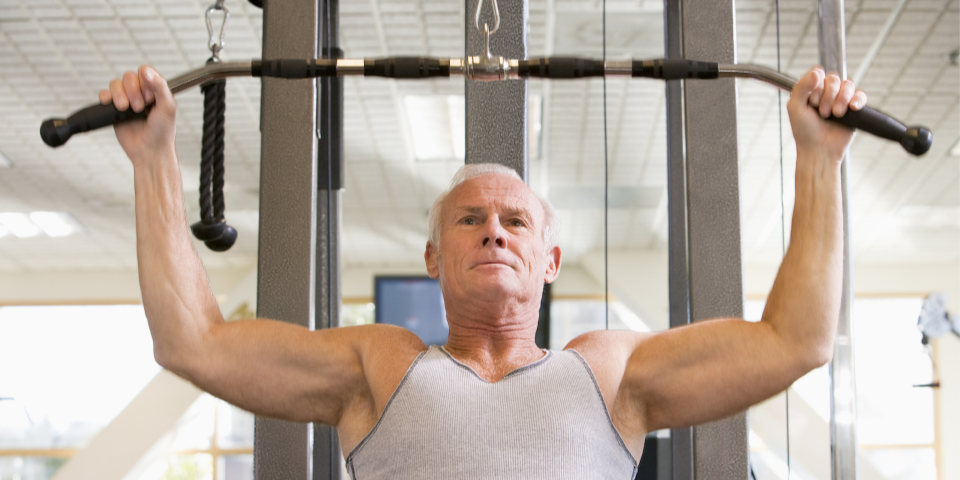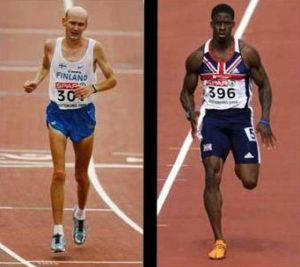We all want to stay strong and vital for as long as possible. Muscle retention is the most important element to staying alive and healthy well into your 90’s and beyond. Skeletal muscle is the largest energy facility in your body and it plays key metabolic roles. Besides force production for physical movement, your muscle participates in the regulation of glucose and lipid metabolism and protects you against insulin resistance and diabetes, cardiovascular disease, cancer, and Alzheimer’s disease.
Losing muscle mass and strength also makes you prone to injuries and keeps you from enjoying the activities you’ve loved for years. Loss of muscle and strength is a major reason people lose mobility and end up in a nursing home. The best way to gain and maintain muscle mass and strength is through weight training. And how you lift those weights can make an enormous difference in your overall results
Muscle wasting, which can eventually develop from low-intensity exercise (i.e., yoga and aerobics), aging, and metabolic disorders, leads to the loss of mental and physical capacity and increased risk for chronic disease. So, how do you turn on your muscle-building mechanisms and rejuvenate your body? I will explain…
Your main muscle-building regulator is an anabolic protein called mTOR. When activated, mTOR instructs your muscle cells to increase protein synthesis and gain size (anabolism or hypertrophy). When mTOR is inhibited, muscle protein synthesis shuts down, resulting in no muscle gain or even a loss of muscle mass (catabolism or atrophy). Researchers found that the main trigger for mTOR is mechanical overload. Mechanical overload is the impact upon muscle that results from intense strength, speed, and explosive drills. Mechanical overload triggers the release of phosphatidic acid, a cellular compound which turns on mTOR to increase protein synthesis in the muscle cells.
Moderate exercise such as yoga and aerobics cannot do this. They lack the intensity needed to stimulate the anabolic impact of mTOR. Moderate exercise affects mainly the mitochondria (the cellular energy facility) leading to endurance, but it barely impacts the myofibrils (contractile apparatus in muscle cells) responsible for strength, speed, and power. Quite often, chronic prolonged aerobics can actually give your muscle the wrong signal and lead to loss of muscle size and diminished strength. Case-in-point, compare the physique of the long-distance runner on the left vs. the sprinter on the right:
You’ve probably heard this story: A child is trapped under a car and in a display of superhuman strength, the child’s mother rushes to the car and lifts the vehicle, rescuing the child from certain death. This is a known phenomenon and is called “hysterical strength.” You may have also heard that chimpanzees and gorillas can be ten times stronger than humans, capable of bending steel bars, punching through walls, or tossing boulders with ease. Both the mother and the apes are relying on a special mechanism designed to keep a muscle from tearing from excessive force. This mechanism is the “inhibition reflex” and here is how it works:
Built into every muscle is something called a Golgi tendon apparatus (GTA). When your muscle contracts and generates a force, the GTA fires nerve impulses to your spinal cord and your spinal cord responds with an inhibition reflex. This inhibition tells your muscle fibers to limit the production of force when the muscle has increased tension. While this mechanism can keep you from tearing your biceps when you’re lifting a sofa, it can also limit your physical performance as you age, such as trying to push the bicycle pedals hard, running up a hill, carrying heavy grocery bags into the house, or quickly recovering your balance instead of falling. In the case of the mother saving her child from the crushing weight of a car or a gorilla escaping from the zoo by bending steel bars, your brain can slightly overpower the inhibition reflex, resulting in a higher threshold of the GTA.
Just like the hysterical mother and the apes, you can increase the excitatory threshold of your GTA to increase your maximum power. In other words, you can “dial down” your body’s natural protective inhibition just a bit. A “super slow” muscular contraction will cause the GTA to turn on before much force can be produced, but with the right kind of weight training, you can trick your muscles into contracting at a higher strength and speed (i.e., power) before the muscle-protecting inhibition turns on. Here’s how:
When lifting weights, the transition between the positive or eccentric contraction phase and the negative or concentric phase should be fast (half-second to 1 second). The entire concentric phase should be characterized by fast and powerful motion. This will activate the type II fast-twitch muscle fibers associated with muscle size and power. The eccentric phase should be short (about 2-4 seconds long). This will activate the type I slow-twitch muscle fibers associated with endurance. This balanced approach will provide optimal hypertrophic stimulus to both type I and II muscle fibers and will help combat the loss of strength, speed, power, endurance, and balance that comes with age.
Comments: Before implementing the information described here, it is important that you work with a Certified Personal Trainer who can show you how to do it correctly to avoid injury. Also, it is important that your primary-care physician first clear you for vigorous exercise.

